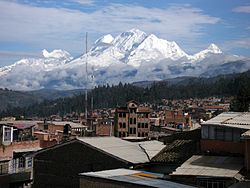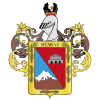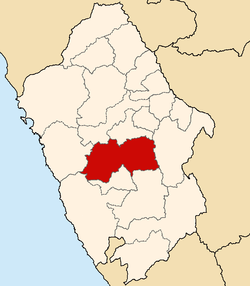| Huaraz | |
|---|---|
| Province | |
 Looking north over Huaraz towards the Cordillera Blanca Looking north over Huaraz towards the Cordillera Blanca | |
 Flag Flag Coat of arms Coat of arms | |
 Location of Huaraz in the Ancash Region Location of Huaraz in the Ancash Region | |
| Country | Peru |
| Region | Ancash |
| Capital | Huaraz |
| Government | |
| • Mayor | Eliseo Rori Mautino Ángeles (2019-2022) |
| Area | |
| • Total | 2,492.91 km (962.52 sq mi) |
| Elevation | 3,052 m (10,013 ft) |
| Population | |
| • Total | 143,415 |
| • Density | 58/km (150/sq mi) |
| UBIGEO | 0201 |
| Website | www.munihuaraz.gob.pe |
Huaraz is one of twenty provinces of the Ancash Region in Peru. It was created on August 5, 1857, during the presidency of Ramón Castilla. Geographically, the province is located over the Callejón de Huaylas and the western slopes of the Cordillera Negra.
The Regional Museum of Archaeology is located in the Huaraz district. Some other highlights of the province are the Pumacayán hill, the hot springs of Monterrey (at 6 km or 4 mi from the city) and the Willkawain archaeological sites, at 13 kilometres (8 mi) to the north of Huaraz, in village of Paria, in the Independencia district.
Geography
The Cordillera Blanca and the Cordillera Negra traverse the province. Some of the highest peaks of the province are Pucaranra, Chinchey, Tocllaraju and Huantsán. Other mountains are listed below:
- Araranca
- Churup
- Jatuncunca
- Cayesh
- Kima Rumi
- Maparaju
- Lake Palcacocha
- Puka Hirka
- Puka Hirka (Aija-Huaraz-Recuay)
- Pucagaga Punta
- Pucaranra
- Puma Waqanqa
- Carhuascancha
- Ranrapalca
- Rima Rima
- Rúrec
- Shacsha
- Tullparaju
- Tuctu
- Tuctopunta
- Ocshapalca
- Uruashraju
- Vallunaraju
- Wamanpinta
- Huamashraju
- Huantsán
- Urus (Carhuaz-Huaraz)
- Yanamarey (Huaraz-Huari-Recuay)
At 30 kilometres (20 mi) from Huaraz, by the route Huaraz–Casma that crosses the Cordillera Negra, there is a place named Punta Callan in the summit of this mountain range. It offers a panoramic sight of the Cordillera Blanca and the Callejón de Huaylas.
Political division
Huaraz is divided into twelve districts, which are the following:
- Cochabamba
- Colcabamba
- Huanchay
- Huaraz
- Independencia
- Jangas
- La Libertad
- Olleros
- Pampas
- Pariacoto
- Pira
- Tarica
Ethnic groups
The province is inhabited by indigenous and mestizo citizens of Quechua descent. Spanish is the language which the majority of the population (63.43%) learnt to speak in childhood, 36.28% of the residents started speaking using the Quechua language (2007 Peru Census).
See also
References
- Alberto Tauro del Pino, Enciclopedia Ilustrada del Perú, vol. VIII, p. 1220.
- Valverde, Guido; Barreto Romero, María Inés; Flores Espinoza, Isabel; Cooper, Alan; Fehren-Schmitz, Lars; Llamas, Bastien; Haak, Wolfgang (2016-06-01). Achilli, Alessandro (ed.). "Ancient DNA Analysis Suggests Negligible Impact of the Wari Empire Expansion in Peru's Central Coast during the Middle Horizon". PLOS ONE. 11 (6): e0155508. Bibcode:2016PLoSO..1155508V. doi:10.1371/journal.pone.0155508. ISSN 1932-6203. PMC 4889149. PMID 27248693.
- escale.minedu.gob.pe - UGEL map of the province of Huaraz (Ancash Region)
- inei.gob.pe Archived 2013-01-27 at the Wayback Machine INEI, Peru, Censos Nacionales 2007
External links
- (in Spanish) Official web site of the province of Huaraz
| |
|---|---|
9°31′38″S 77°32′00″W / 9.52722°S 77.53333°W / -9.52722; -77.53333
This Ancash Region geography article is a stub. You can help Misplaced Pages by expanding it. |